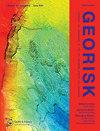基于混合物理数据的DNN在沉管隧道节点轴向位移预测中的应用
IF 4.8
3区 工程技术
Q1 ENGINEERING, GEOLOGICAL
Georisk-Assessment and Management of Risk for Engineered Systems and Geohazards
Pub Date : 2023-01-02
DOI:10.1080/17499518.2023.2169941
引用次数: 1
摘要
摘要由于沉洞与周围环境相互作用复杂,对沉缝轴向位移(DIS)进行理论分析比较困难。为了建立一个广义的DIS预测模型,可以考虑深度神经网络(DNN)。然而,黑盒深度神经网络模型的空间泛化对于小数据并不总是可信的。本文提出了一种基于混合物理数据(HPD)的深度神经网络模型,该模型具有改进的空间泛化能力,并首先通过与其他监测数据的相关性分析了DIS的物理机制。然后根据物理分析创建HPD,并将其作为替代特征而不是附加特征贡献给DNN。比较了三种不同特征组的DNN模型,而提出的HPD-DNN在预测泛化和准确性方面都优于其他模型。排列特征重要性分析表明,HPD有效地增强了DNN的物理解释,支持了物理分析的结果。进一步验证了HPD的应用,不仅可以增强DNN预测的空间泛化,还可以增强其他黑箱模型的空间泛化,有望解决岩土工程中数据不足的问题。本文章由计算机程序翻译,如有差异,请以英文原文为准。
A hybrid physical data informed DNN in axial displacement prediction of immersed tunnel joint
ABSTRACT Due to complex interactions between immersed tunnel and surrounding environment, it is difficult to apply theoretical analysis for axial displacement (DIS) of immersion joints. To develop a generalised model for DIS prediction, Deep Neural Network (DNN) could be considered. However, the spatial generalisation of black-box DNN models is not always convincible for small data. In this study, we proposed a novel hybrid physical data (HPD) informed DNN model with improved spatial generalisation for prediction of DIS. The physical mechanism of DIS is firstly analysed by correlation between DIS and other monitoring data. The HPD is then created based on the physical analysis and contributes to the DNN as a substituting feature rather than an additional feature. Three DNN models fed with different groups of features are compared, while the proposed HPD-DNN has outperformed others in terms of both prediction generalisation as well as accuracy. The permutation feature importance analysis reveals that HPD has effectively enhanced physical interpretation of DNN, which supports the results stated in physical analysis. The application of HPD is further verified to enhance the spatial generalisation of prediction for not only DNN but also other black-box models, which is promising for insufficient data problems in geotechnical engineering.
求助全文
通过发布文献求助,成功后即可免费获取论文全文。
去求助
来源期刊
CiteScore
8.70
自引率
10.40%
发文量
31
期刊介绍:
Georisk covers many diversified but interlinked areas of active research and practice, such as geohazards (earthquakes, landslides, avalanches, rockfalls, tsunamis, etc.), safety of engineered systems (dams, buildings, offshore structures, lifelines, etc.), environmental risk, seismic risk, reliability-based design and code calibration, geostatistics, decision analyses, structural reliability, maintenance and life cycle performance, risk and vulnerability, hazard mapping, loss assessment (economic, social, environmental, etc.), GIS databases, remote sensing, and many other related disciplines. The underlying theme is that uncertainties associated with geomaterials (soils, rocks), geologic processes, and possible subsequent treatments, are usually large and complex and these uncertainties play an indispensable role in the risk assessment and management of engineered and natural systems. Significant theoretical and practical challenges remain on quantifying these uncertainties and developing defensible risk management methodologies that are acceptable to decision makers and stakeholders. Many opportunities to leverage on the rapid advancement in Bayesian analysis, machine learning, artificial intelligence, and other data-driven methods also exist, which can greatly enhance our decision-making abilities. The basic goal of this international peer-reviewed journal is to provide a multi-disciplinary scientific forum for cross fertilization of ideas between interested parties working on various aspects of georisk to advance the state-of-the-art and the state-of-the-practice.

 求助内容:
求助内容: 应助结果提醒方式:
应助结果提醒方式:


